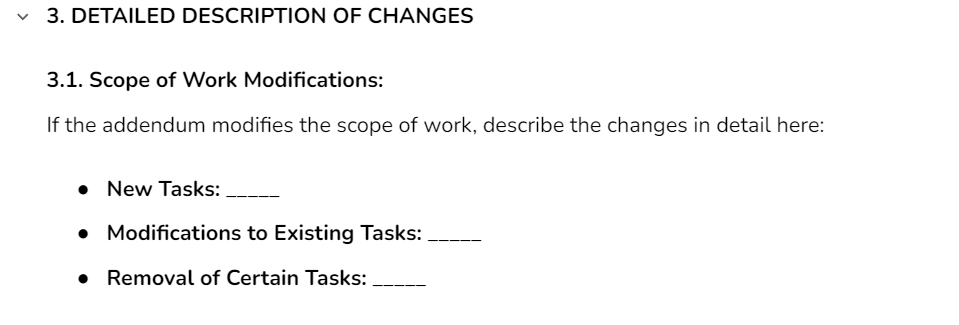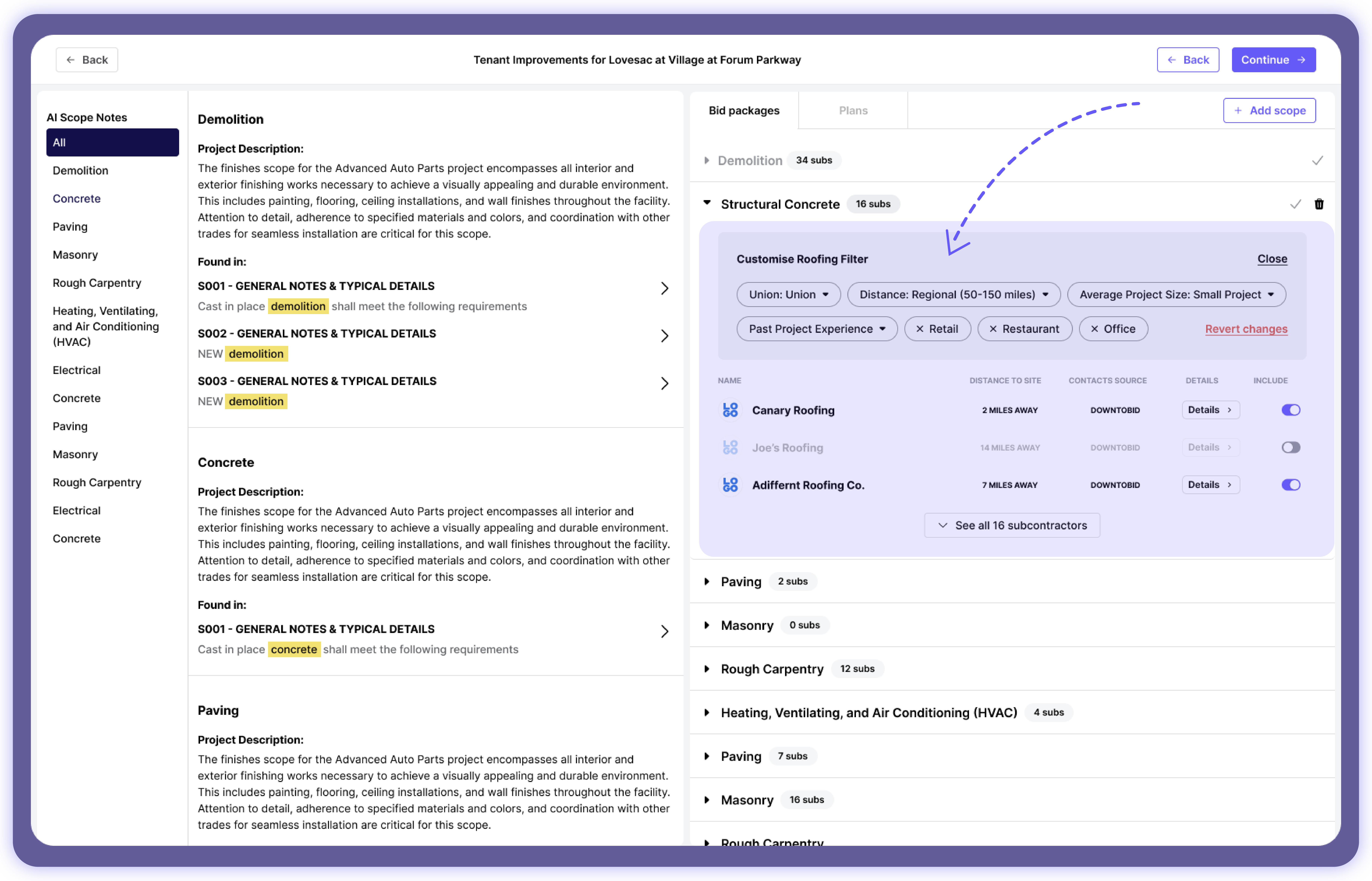Construction projects evolve, and changes to original plans become necessary. Addenda offer a formal method to document these changes. They make sure everyone’s on the same page when the original plan needs a tweak, reducing risks tied to miscommunication or oversights.
In this guide, we’ll break down what addenda are, why they matter in construction, and provide a simple construction addendum template that you can put to work right away.
Note: Need help analyzing construction plans and sending bid invites? Give Downtobid a try. Our AI examines your construction plans, identifying key elements and scope items. Based on its analysis, the system generates appropriate bid packages for your project and compiles a list of relevant subcontractors for each bid package. To top it off, it creates personalized bid invitations to help you get more bids for your construction project. Try a demo today (for free) and experience firsthand how Downtobid can streamline your preconstruction processes.
Key Takeaways
- Construction addenda document contract changes during bidding to clarify requirements and reduce miscommunication.
- Common reasons: scope changes, design fixes, material issues, timeline adjustments, budget revisions.
- Addenda clarify contracts before bidding; change orders modify contracts during construction.
- Effective addenda need clear language, adequate detail, proper enforceability, avoid vague terms.
- Downtobid's bid board centralizes addenda management, organizing communications, saving 3 hours weekly.
Construction Addendum in a Nutshell
Addendum refers to an official document that modifies, clarifies, or adds to the original contract. It communicates changes or new information affecting the project, typically during the bidding process. These changes can range from simple date extensions to complex revisions of payment schedules and deliverables.
Here are some common reasons why you might need to issue an addendum:
- Adding or removing tasks from the project scope -- maybe there’s extra work or something that’s no longer needed.
- Fixing mistakes or filling in gaps in the original design.
- Dealing with construction materials that aren’t available anymore.
- Changing up the client’s requirements.
- Adapting to new codes, relevant regulations, or to ensure compliance with laws that impact the project.
- Adjusting the project timeline, whether it’s due to delays or a need to speed things up.
- Revising the project budget or making cost adjustments, especially if material costs or labor cost calculations have changed.
- Addressing geological surprises or site conditions that weren’t what you expected.
Addendum vs. Change Order?
Before we go any further, let’s clarify a common confusion: addenda and change orders. Although they may seem alike, they serve different purposes in construction.
Change orders modify an existing contract to reflect significant changes in the scope of work for the project. These documents come into play when unexpected conditions arise during construction. For instance, discovering structural issues or accommodating client-requested changes that significantly impact the scope, budget, or timeline. You can read more about change orders and download a free construction change order template here.

On the other hand, an addendum is more about tidying things up before the project kicks off. It’s used to make minor tweaks or clarify the contract before the construction bidding process. This could mean clearing up confusing terms or adding details that bidders need to know to put together accurate bid proposals.
The timing of these documents marks a key difference. Addenda are usually issued before bids are submitted, so contractors can factor these changes into their pricing. Unlike change orders, they don’t require the same level of formal agreement because they’re meant to clarify, not alter, the core terms of the original document.
Download Our Free Construction Addendum Template
Our construction addendum template offers a consistent format for documenting project changes. This tool streamlines the process of creating addenda across multiple construction projects, maintaining clarity and professionalism in your documentation.
The template's pre-built structure eliminates the need to start from scratch each time a project change occurs. Its standardized layout ensures all addenda follow a similar format, making them easier to read, understand, and implement.
Of course, not every part of the template will fit your project perfectly, so feel free to tweak and include your own information on the necessary changes. You can make a copy of the free template here.

Creating an Effective Addendum (Mistakes to Watch Out For)
Addenda, while handy for updates contracts, are not immune to challenges or disputes. You'll need to avoid these common pitfalls when creating your construction addendum to minimize possible misunderstandings:
- Vague language: If the language in an addendum is unclear, it opens the door to different interpretations. When that happens, you’re looking at a potential dispute, with each party possibly having a different take on what the addendum actually changes.
- Cardinal change doctrine: If an addendum drastically shifts the scope of work or obligations, taking them far from what was originally agreed upon, it might be challenged under the cardinal change doctrine. This legal principle protects contractors from performing work that’s completely different from the initial agreement. In such a case, a legal professional is often involved.
- Inadequate detail: Addenda must explicitly state which provisions of the original contract they alter. Failing to do so can create confusion and open the door to disputes. Effective addenda leave no room for guesswork, clearly outlining the exact changes to the original agreement. Even the addendum title needs to be as clear as possible, so there's no ambiguity about what it covers.
- Enforceability: Make sure your addendum meets the original contract’s requirements for changes. Many contracts stipulate that changes must be in writing and signed by all relevant parties. An addendum that fails to meet these criteria may face legal challenges, potentially rendering it unenforceable.
Stay on Top of Addendums with Downtobid
Addenda can pile up fast. One change often triggers another, creating a cascade effect. While this might not necessarily derail your project, how you manage and communicate these changes can be a big issue, especially when they multiply.
Email is the usual go-to for sharing updates in construction for both general contractors and subcontractors.
This communication approach, however, creates challenges for subcontractors. Their inboxes often overflow with messages, forcing them to spend excessive time sorting through irrelevant information to find crucial addenda.
One of our recent surveys sheds more light on this issue. Chief estimators spend roughly 3.5 minutes per email performing various tasks:
- Reading and responding to messages
- Removing unnecessary emails
- Updating bid boards
- Forwarding information to estimators
- Saving documents to project folders
More concerning, nearly half of all emails generate no revenue, yet consume valuable time from the most critical member of the estimating team -- the chief estimator.
The Solution? An automated bid board like Downtobid.
First, it centralizes all company emails, organizing them by project.

It then classifies and directs emails to appropriate projects. For example, all addenda and updates for a specific project are neatly organized, so your chief estimator can move from sorting to simply reviewing bids.

To put it simply, it connects to your inbox, identifies bid invitation emails, and extracts key data such as deadlines, bidders, and addenda into a comprehensive dashboard. This automation eliminates manual data entry and saves substantial time, allowing you to focus on the more demanding aspects of your construction projects. In fact, some of our users report saving up to 3 hours per week per team member.
Ready to see it in action? Sign up for a demo today.
Take the Hassle Out of Preconstruction with Downtobid
The bid board is just one part of what our platform offers. There’s a lot more to discover, with benefits for both general contractors and subcontractors alike.
For general contractors:
- You can speed through page turns without missing crucial information. Our AI checks all major trades and even writes a brief summary to prevent missed scopes.
- The AI Copilot suggests appropriate bid packages and matches them against a list of qualified, local subcontractors. This streamlines the selection process and helps ensure you're working with the right teams.
- The AI generates personalized ITBs that highlight a subcontractor's expertise and detail the scope of work, allowing them to determine their fit for the project from the initial communication.

For subcontractors:
- Our AI Copilot scans every plan set and bid invitation you receive. It detects scope related to your specific trade, allowing you to focus on relevant opportunities.
- When an invitation aligns with your project focus, our AI automatically adds it to your bid board or calendar. Essential project details, such as deadlines, project name, and GC information, are included, streamlining your workflow.
- You can keep track of your success rate with detailed analytics, so you can see what’s working and where you can improve.
Want to see these features in action? Upload your construction plans today or sign up for a demo to explore the bid board and more.